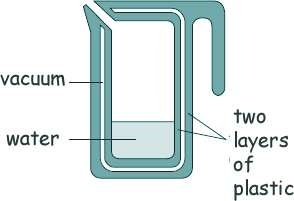Heat Questions - GCSE Level Q12. (a) Heating food in a saucepan over a gas flame is inefficient. Suggest why. Some of the energy from the gas flame is wasted as it is transferred to surroundings [2 marks] (b) A new saucepan has been designed that heats up food much faster than a traditional saucepan. The diagram below shows the two saucepans.
Describe how the features of the new saucepan cause the food to heat up faster than when the food is heated in the traditional saucepan. The fins increase the surface area [2 marks] (c) State the relationship between the temperature of the saucepan and the rate at which the saucepan emits infrared radiation. The higher the temperature of the saucepan the greater the rate at which infrared radiation is emitted - there is a positive correlation between the two. [1 mark] (d) A new design for a kettle has also been suggested. It is made from two layers of plastic separated by a vacuum. After the water in the kettle has boiled, the water stays hot for at least 2 hours. Here is a diagram of the design.
Explain why the vacuum reduces energy transfer to the surroundings and keeps the water warm for a longer time than a traditional kettle. There are no particles in a vacuum [3 marks] (8 marks total) |
Follow me...
|







